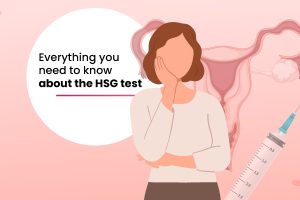Is it possible to get pregnant with high AMH levels?

Author: Dr. V Ramya, Consultant & Fertility Specialist
While planning for a pregnancy, various factors like fertile window, ovarian conditions, egg and sperm health, and hormones play a role in conception. One such hormone of significance is AMH or Anti-Müllerian Hormone.
Firstly, what is AMH?
Also known as MIS – Mullerian Inhibiting Substance, it is an essential hormone for male and female genital development during the fetal stage.
AMH is produced in the testicles by men. With concern to males, it is of no clinical importance.
In women, AMH is produced in the ovarian follicles. It helps in the growth and maturation of ovarian follicles.
How is AMH testing conducted?
AMH test is a blood test. A blood sample is taken and processed to test for AMH levels. AMH testing can be done at any point of time in the month as AMH levels do not change with the menstrual cycle.
Importance of AMH testing
· Although measuring AMH levels can shed light on a range of female reproductive health issues like PCOD, AMH is essentially employed as a biomarker for measuring ovarian reserve. It is used to estimate the approximate number of eggs remaining in the ovaries.
· AMH testing helps in decision-making for women considering freezing their eggs.
· Lack of menstrual cycle (amenorrhea) in teenage girls can be diagnosed by monitoring AMH levels.
· It also helps in predicting the outcome of fertility treatments like IVF and IUI.
· Predicts the beginning of menopause.
What are the normal AMH levels?
AMH levels are evaluated based on the age group of the woman.
During adolescence, AMH levels start increasing and peak at the age of 25. AMH levels decline naturally in every woman with increasing age. Hence low levels of AMH indicate low egg reserve and vice versa.
Standard levels are variable. Below are general ranges for AMH levels.
· Average: Between 1.0 ng/mL to 4.0 ng/mL (approximately).
· Low: Under 1.0 ng/mL
· Extremely low: Below 0.4 ng/mL
AMH levels as per age groups:
Below are the approximate minimum levels for each respective age group.
· 25 years old: 3.0 ng/mL.
· 30 years old: 2.5 ng/mL.
· 35 years old: 1.5 ng/ mL.
· 40 years old: 1 ng/mL.
· 45 years old: 0.5 ng/mL.
AMH levels and pregnancy:
AMH levels affect the chances of pregnancy. Any woman in the fertile age group of 25 – 30 years old and with an AMH reading of 2.5 ng/mL to 3.5 ng/mL has a better chance of having a pregnancy than older women and women with lower AMH levels.
Is high AMH a good thing?
Although, high AMH levels are associated with a good ovarian reserve and the presence of a large number of eggs, it does not signify the quality of the eggs which is also an important factor that plays a role in conceiving and the outcome of a fertility treatment. AMH levels can’t be used to evaluate the quality of eggs.
Increased AMH levels don’t necessarily lead to good chances of pregnancy.
Any AMH reading above 4.0 ng/mL is abnormally high and is a matter of concern.
Abnormally high AMH levels indicate polycystic ovary syndrome (PCOS) a hormonal condition characterized by the presence of fluid-filled sacs in the ovaries which trigger high production of AMH.
In the case of egg freezing, high AMH levels can make you more susceptible to developing ovarian hyperstimulation syndrome (OHSS).
High AMH levels are also characteristic of certain cancers of the female reproductive system like ovarian cancer, and granulosa cell tumors.
What is a Good AMH Level to Get Pregnant?
An AMH level of 1.0–4.0 ng/ml is considered as a good level to conceive.
Low AMH levels
Low AMH levels indicate a low or decreased number of eggs in the ovaries. And fewer number of eggs implies less chance of getting pregnant and there might be difficulty while trying to get pregnant naturally. However, you can still have a baby with the help of assisted reproductive technologies.
Reasons for low AMH levels
Here are a few reasons for low AMH levels:
Age:
Age is the most important factor that affects AMH levels. As the number of eggs decreases with the increasing age, the AMH levels too start to drop significantly, indicating that the chances of getting pregnant start to reduce with increasing age.
Diet:
The food we consume also plays a major role in low AMH levels. Consuming a diet that includes processed sugars and fats affects the egg quality directly impacting AMH levels along with other reproductive issues. Vitamin deficiency such as Vitamin D deficiency also affects fertility and AMH levels. Hence, it is important to have a balanced diet to improve AMH levels along with overall reproductive health.
Stress levels:
Stress is a leading cause of infertility among women. A healthy and peaceful state of mind is essential for women who are trying for a pregnancy. Managing stress has been shown to improve AMH levels and conception chances
Past Medical Issues:
Adverse medical issues impact the reproductive system and affect AMH levels. Hormonal imbalances due to sedentary lifestyle and stress lead to decreased AMH levels. Women with a genetic history of cancer, ovarian disorders, and early menopause are at a high risk of having low AMH levels.
Significance of AMH levels in IVF
IVF is not only about the quality of eggs; it is also about the number of eggs that can be retrieved for fertilization. During the IVF process, AMH levels are assessed to get a clear picture of the egg number and the ovarian age of a woman. It reveals how well you are likely to respond to the fertility medications that are used to stimulate the ovaries to produce multiple mature eggs. It also helps in deciding the treatment course along with an estimation of the chances of having a pregnancy.
Lifestyle tips to maintain good AMH levels to get pregnant
Here are a few tips you might want to consider to maintain your AMH levels.
- Maintain a healthy BMI
- Limit coffee, alcohol, and tobacco intake
- Manage stress
- Stay hydrated. Eat a healthy and balanced diet.
- Consider taking fertility supplements (Under a doctor’s supervision)
- Reduced intake of refined products
Take away:
AMH levels alone don’t decide your fertility status. Other associated reproductive factors such as uterine status, tubal health, sperm factors, and underlying medical conditions contribute to conception.
On the optimistic side it is safe to say that even with fewer chances of conceiving, one can still get pregnant with a low egg count or low levels of AMH.










